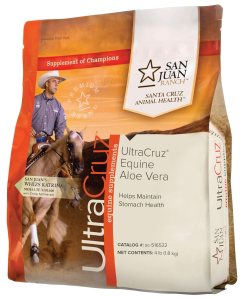Using Aloe Vera Juice for Equine Gastric Ulcers
Introduction
Gastric ulcers can be a painful and distressing condition for horses. Fortunately, nature provides us with remedies that can complement traditional treatments. Aloe vera juice, derived from the succulent plant Aloe barbadensis, has gained attention as a potential aid in managing gastric ulcers in horses. Let’s explore how this natural elixir works and how to incorporate it into your horse’s care.

How Aloe Vera Works
Aloe works in two ways; soothing and ani-inflammatory.
- Soothing the Digestive Tract: Aloe vera forms a protective layer over the stomach lining and intestines, reducing their exposure to gastric acids. This action is akin to the horse’s natural mucosal lining, which may be weakened or damaged in horses with ulcers.
- Active Ingredients: Aloe vera gel contains several bioactive compounds, including vitamins, minerals, enzymes, acetylated mannans, polymannans, anthrones, anthraquinone, and lectins. These components contribute to its anti-inflammatory, antioxidant, and antimicrobial effects.
How Do I Use Aloe Vera Juice?
Adding Aloe Vera Juice into your horse's diet is easy! You can find this wonderful product in a powdered, gel or liquid form. I like the gel and pelleted forms for ease of use.
Products and Dosage Guidelines
There are tons of great products out there but here are a few of my favorite products in the various forms. These are ones I have tried and feel good recommending. Click on any image or link to order through Amazon.
Gel: Aloe Agave I used this product on my horse Finn. It is on the higher priced side of products but I love the addition of Blue Agave which acts as a prebiotic for the hind gut. Follow dosage instructions on package.

This product, George's Aloe is more affordable way to use Aloe Vera gel but it is without the Blue Agave. I switched to this after Finn was ulcer free. Administer 20 ml by syringe twice a day.

Pelleted: Ultra Cruz For your picky eaters, this is the way to go. Each serving contains the equivalent of 10,000 mg of Aloe Vera Gel in a tasty, easy to use pellet. Follow package instructions.

Important Considerations
Using Aloe Vera should be considered as a Complement to Traditional Treatment. While aloe vera may help manage ulcers, it is essential to address underlying risk factors that contributed to ulcer formation. Proper dietary and management practices play a crucial role. These include reducing stress, lots of turn out, lots of good quality fiber in their diet, and reducing grains.

Omeprazole vs. Aloe Vera: Omeprazole (GastroGuard or Ulcerguard) remains the standard pharmaceutical treatment for ulcers. However, it cannot be used long term as horses need the acid in their stomachs for proper digestion.
Although aloe vera improved ulcer severity in one study, it did not match the efficacy of omeprazole, therefore it should not be your first line in treating an active ulcer. Consider it more as a preventive after the active ulcer is healed. Work with your vet to develop a treatment plan. Most vets recommend 28 days of Ulcerguard after scoping and identifying ulcers.

Conclusion
Aloe vera juice offers a gentle and natural approach to supporting gut health and alleviating gastrointestinal discomfort in horses. Consult with your veterinarian to determine the best regimen for your horse, considering individual needs and overall management. As a hippie, I always find a holistic approach that combines proper care, nutrition, and natural supplements is the best way to ensure your horse’s well-being.
Remember, a healthy horse is a happy horse!
Peace and good rides,
Laura

The Horse Hippie
Links:



Leave a comment